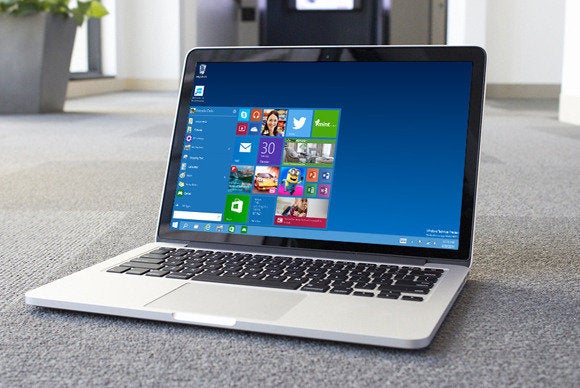Even if you plan to keep using your PC after you purchase your Mac, you'll want to move your files to the Mac just to have another backup. If your PC has an Ethernet port or WiFi wireless connection, you can network your PC to the Mac, set up your PC as a file server, and then copy over everything you need.
When it works, networking is the easiest way to transfer your files. But some settings can easily get messed up along the way. You also need enough free disk space on the Mac to hold all your files. And when you're all done transferring the files, you still should make a backup copy of everything.
1Connect the Mac and PC to the same network.
Despite the Mac's recent gains in market share, Windows is still the dominant operating system, especially in businesses. That means there may be times when you need to run the Microsoft OS. This content applies to Windows Virtual Desktop with Azure Resource Manager Windows Virtual Desktop objects. If you're using Windows Virtual Desktop (classic) without Azure Resource Manager objects, see this article. (Lucas's MacLifeHacks #28) If you're going from Windows to Mac - even if you made the switch long ago - you need these basic and pro tips. After 16 years hel. Boot Camp 5.1 includes several Mac drivers so that Windows will recognize your trackpad, Thunderbolt, USB 3.0, the iSight (or FaceTime) camera, the Eject key on the Mac keyboard, networking, audio, graphics, and so on. A Boot Camp Control Panel for Windows. Use Windows Migration Assistant to transfer your pictures, documents, and other data from a Windows PC to your Mac. Windows Migration Assistant transfers your contacts, calendars, email accounts, and more from a PC.
If your home network doesn't have WiFi, you need an Ethernet cable. Plug the Mac into your Ethernet router or even better, just run an Ethernet cable between the Mac and the PC. You can borrow the one that connects your PC to your high-speed Internet modem, if you have one. (Don't forget to put it back when you're done.)
2Enable file sharing on the PC.
First, determine whether your Mac has already detected your PC on the network. In the Finder, choose Go→Network. Then, click the various icons in the Network browser that appears to see whether your PC's icon is among those that appear. If you don't see your PC from the Mac, choose Start→Control Panel on the PC and double-click the Network Setup Wizard icon. Follow its instructions. Make a note of the name you give your computer and the workgroup name that gets assigned in the margin.
3Make the files and folders you want to transfer sharable.
After you've set up file sharing, drag the folders on the PC that you want to access on your Mac to the Shared Folder on the PC desktop. Alternatively, you can right-click any folder you want to share and select Properties from the menu that appears. Click the Sharing tab and select the Share This Folder on the Network check box.

4Access the shared folders from your Mac.
On the Mac side, choose Go→Network and look for icons with the names you just assigned. Double-click those icons. You should see your PC folders appear on the Mac desktop.
5Move the files.
From the Finder menu, choose New Folder. Name the folder My PC files or whatever you want. Now drag all the files you want to this folder. For extra neatness points, make separate folders for each folder you bring over from the PC, such as My Documents, My Pictures, My Movies, and so on, matching the names you used on your PC. You won't regret spending some quality time getting your files and folders organized after they are safely on the Mac. When you're done, move them all to your Mac's Documents folder.
Right click
Xbox controller mac bluetooth. Click the right corner of your Apple mouse, or click with two fingers on your Apple trackpad. You can change this in Mouse preferences and Trackpad preferences.
Scroll, swipe, click
Settings for scroll direction, swipe gestures, and button assignments are also in Mouse and Trackpad preferences.
Close & resize windows
Buttons for closing, minimizing, and maximizing a window are in the upper-left corner of the window.
Change volume
Use the volume control in the menu bar, or use the volume keys on your Apple keyboard.
Find files
Use Spotlight to quickly find and open apps, documents, and other files.
Open apps
You can also use Launchpad and the Dock to open your apps (programs).
Browse for files
Looking for Windows File Explorer? Learn about the Finder.
Throw files away
Looking for the Recycle Bin? Use the Trash, which is in the Dock. What is paragon ntfs for mac os x.
Rename files
Click the file once to select it, then press the Return key and type a new name. Press Return when done.
Preview files
Preview most files on your Mac using Quick Look. Click the file once to select it, then press Space bar.
Back up files
Time Machine keeps a copy of all your files, and it remembers how your system looked on any given day.
Change Mac settings
Looking for the Control Panel? Use System Preferences instead.
Many Mac keyboard combinations use the Command (⌘) key. Learn more keys and keyboard shortcuts.
Cut
Copy
Paste
Undo
Close window
Switch apps
Quit app
Forward delete
Find files
Force quit app
Switch From Windows To Mac Boot Camp
Take screenshot
Learn more
Windows To Mac Migration Assistant
- For more information to help you get to know your Mac, use the Help menu in the Finder menu bar.
- What's it called on my Mac? includes additional Windows and Mac terms.
